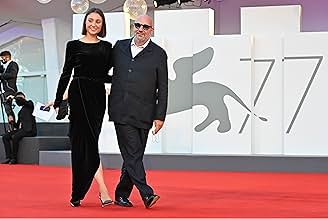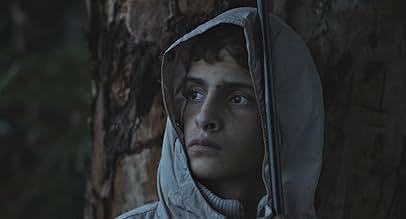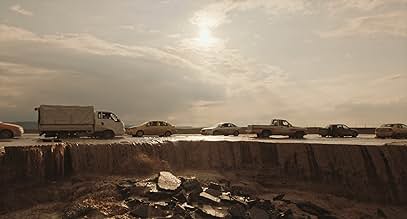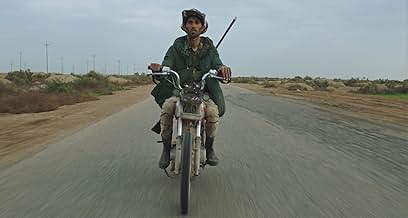CALIFICACIÓN DE IMDb
6.6/10
1.4 k
TU CALIFICACIÓN
Un documental sobre los que intentan sobrevivir en un Oriente Medio devastado por la guerra.Un documental sobre los que intentan sobrevivir en un Oriente Medio devastado por la guerra.Un documental sobre los que intentan sobrevivir en un Oriente Medio devastado por la guerra.
- Dirección
- Guionista
- Premios
- 7 premios ganados y 15 nominaciones en total
Opiniones destacadas
Though the fim begins with an introductory text on the modern history of the Middle-East, it focuses on specific scenes and people at the seeming end to the current phase of the conflicts. Some scenes depict the mundane day to day existence of the wars, while in others people are trying to reconcile what they have experienced through art. There is also an element of the environment in how the wars effect nature itself. Though sad in essence, the visuals of the film are stunning and immersive.
Nice images without context. These could have been observed anywhere, with or without a war or other threats around. Did I not have similar problems with Fire At Sea / Fuocoammare at Berlinale 2016?? My first thoughts at the time were that I saw nothing new and revolutionary. Other attendees made me doubt, however. The reactions of people around me forced me to re-think what impact such a documentary can have on the average viewer, apparently on them. What did I miss??
I've seen many documentaries around the same topic in 2016/2017, which causes a certain distance and some feeling that all this should be common knowledge already. Still, images like this seem to impress people. Maybe it showcases the term "impressionistic" I see in many reviews, something that I did not understand when explained at school, and still goes above my head nowadays. Viewers knowledgeable about the context seem able to connect the dots when letting these images pass by. I wonder how it would be received by someone who was not told beforehand what the central topic of conversation was.
Some of the images (1/3 as I mentioned before) can be understood without context, like the women mourning in a prison cell, the soldiers jogging/marching at dawn, soldiers surveying the environment from a shelter, stage players practicing their lines (quoting clear texts about the sorry state of their country), school children explaining their drawings, and so on. Those parts really were memorable. The other 2/3 went past me.
I sat it out through the end, but still do not understand the value of this documentary (if any). Maybe I just don't like kaleidoscopic movies, presenting a series of images/scenes that are not related to each other, not telling a story but merely painting an image where we are pressured to connect the dots and understand what the filmmakers try to convey. It is lost on me, in any case. Another explanation can be that I saw so many documentaries (part of IDFA, Movies That Matter, and other festivals) that are so much more illuminating and compelling, that this one in comparison does very little to pique my interest. It tells nothing new, and just repeats the obvious in a slightly different way but not adding any value. Leaves us with the nice images.
I've seen many documentaries around the same topic in 2016/2017, which causes a certain distance and some feeling that all this should be common knowledge already. Still, images like this seem to impress people. Maybe it showcases the term "impressionistic" I see in many reviews, something that I did not understand when explained at school, and still goes above my head nowadays. Viewers knowledgeable about the context seem able to connect the dots when letting these images pass by. I wonder how it would be received by someone who was not told beforehand what the central topic of conversation was.
Some of the images (1/3 as I mentioned before) can be understood without context, like the women mourning in a prison cell, the soldiers jogging/marching at dawn, soldiers surveying the environment from a shelter, stage players practicing their lines (quoting clear texts about the sorry state of their country), school children explaining their drawings, and so on. Those parts really were memorable. The other 2/3 went past me.
I sat it out through the end, but still do not understand the value of this documentary (if any). Maybe I just don't like kaleidoscopic movies, presenting a series of images/scenes that are not related to each other, not telling a story but merely painting an image where we are pressured to connect the dots and understand what the filmmakers try to convey. It is lost on me, in any case. Another explanation can be that I saw so many documentaries (part of IDFA, Movies That Matter, and other festivals) that are so much more illuminating and compelling, that this one in comparison does very little to pique my interest. It tells nothing new, and just repeats the obvious in a slightly different way but not adding any value. Leaves us with the nice images.
I don't know Rosi's work as a cameraman, but can imagine some directors like long takes in wide angle, especially when content is not the main thing. So this is documentary 'art' ? Three years of film-making and I see material that's general, could be anywhere, even an LA backwater. Certainly better on a big screen, but watch out if you have a comfortable chair too, as you might sleep and miss most of it.
Several years ago, Gianfranco Rosi lectured to an audience of university students (myself included) about his next project: it would be filmed exclusively at night, he said, and take place over much of the Middle East. He asked that we not release any of this information - assured of the secret pact with his audience. I had more or less forgotten about this project until recently, when I discovered it had been selected as the Italian entry for the Best International Feature Film at the 93rd Academy Awards, and was being distributed by MUBI.
Notturno ("night," or "of the night") is a collection of brief glimpses into the lives of people across Syria, Lebanon, Iraq and the Kurdistan region of northern Iraq. From dark swamplands to inner cities, fisherman, soldiers and teachers, to name a few, are brought into the documentary's compass. Few words are spoken by those selected, and much of their action or routine takes place in quietness - a sort of calm in the aftermath of a terrible storm. Rosi's observational and distant study only partly takes places at night; many scenes are filmed in the soft glow of dawn or twilight, and many in bright sunlight.
For a while, I was sceptical about the documentary's artistic license. There is near-perfect composition to each frame, and the theatrical recreation of war by the amateur, psychiatric patients reminded me of Joshua Oppenheimer's The Act of Killing (where civilians and dictators are made to dramatise the traumas of their past). And yet, I found myself compelled by Notturno's visual storytelling, by the sparseness of its landscapes and sound. There are stories within these images, and sometimes they need to speak for themselves, without the aid of conventional narration or voiceover.
Notturno ("night," or "of the night") is a collection of brief glimpses into the lives of people across Syria, Lebanon, Iraq and the Kurdistan region of northern Iraq. From dark swamplands to inner cities, fisherman, soldiers and teachers, to name a few, are brought into the documentary's compass. Few words are spoken by those selected, and much of their action or routine takes place in quietness - a sort of calm in the aftermath of a terrible storm. Rosi's observational and distant study only partly takes places at night; many scenes are filmed in the soft glow of dawn or twilight, and many in bright sunlight.
For a while, I was sceptical about the documentary's artistic license. There is near-perfect composition to each frame, and the theatrical recreation of war by the amateur, psychiatric patients reminded me of Joshua Oppenheimer's The Act of Killing (where civilians and dictators are made to dramatise the traumas of their past). And yet, I found myself compelled by Notturno's visual storytelling, by the sparseness of its landscapes and sound. There are stories within these images, and sometimes they need to speak for themselves, without the aid of conventional narration or voiceover.
Gianfranco Rosi's "Notturno" (2020) presents itself as a visually striking, yet thematically fragmented documentary that attempts to capture the raw essence of life in the Middle East's war-torn regions. While the film's ambition is admirable, it suffers from several significant flaws that detract from its potential impact.
Firstly, the film's length is a major drawback. At over two hours, "Notturno" feels unnecessarily prolonged, with many scenes stretching beyond their welcome. This extended runtime exacerbates the film's lack of a clear narrative thread. Without a discernible red line connecting the various vignettes, the audience is left to navigate a series of disjointed moments that lack coherence. This absence of a central narrative theme makes the film feel more like a loosely connected collage than a cohesive documentary.
The decision to forgo a musical score further hinders the film. While the absence of music might be intended to emphasize the starkness of the realities depicted, it instead leaves the film feeling monotonous and emotionally flat. Music could have provided a much-needed emotional anchor or rhythm to the film, guiding the viewer through its otherwise repetitive and rhythmically inert sequences.
Speaking of repetition, "Notturno" suffers from a noticeable lack of variation in its shots and scenes. The visual compositions, while often beautiful, become redundant over time. The consistent use of similar framing and pacing contributes to a sense of stagnation, making the film's already slow pace feel even more sluggish.
Moreover, the editing choices leave much to be desired. The film's montage lacks rhythm, and the pacing feels uneven, contributing to a viewing experience that drags rather than engages. The slow, deliberate pacing might be meant to evoke a sense of contemplation, but instead, it often feels ponderous, testing the audience's patience.
Finally, "Notturno" provides little to no context for the scenes it presents. While Rosi's observational style aims to let the images speak for themselves, the lack of explanatory background leaves the viewer grasping for meaning. The film assumes a level of prior knowledge about the region and its conflicts that not all viewers may possess, making it difficult to fully grasp the significance of what is being shown.
In conclusion, while "Notturno" is visually impressive and undoubtedly captures powerful moments, it is weighed down by its excessive length, lack of narrative cohesion, repetitive visuals, and absence of musical or rhythmic structure. The film's minimal context further alienates viewers, leaving them to wade through a disjointed and often tiresome portrayal of life in a conflict zone. Gianfranco Rosi's ambitious vision ultimately falls short, resulting in a documentary that, while occasionally poignant, fails to fully engage or enlighten.
Firstly, the film's length is a major drawback. At over two hours, "Notturno" feels unnecessarily prolonged, with many scenes stretching beyond their welcome. This extended runtime exacerbates the film's lack of a clear narrative thread. Without a discernible red line connecting the various vignettes, the audience is left to navigate a series of disjointed moments that lack coherence. This absence of a central narrative theme makes the film feel more like a loosely connected collage than a cohesive documentary.
The decision to forgo a musical score further hinders the film. While the absence of music might be intended to emphasize the starkness of the realities depicted, it instead leaves the film feeling monotonous and emotionally flat. Music could have provided a much-needed emotional anchor or rhythm to the film, guiding the viewer through its otherwise repetitive and rhythmically inert sequences.
Speaking of repetition, "Notturno" suffers from a noticeable lack of variation in its shots and scenes. The visual compositions, while often beautiful, become redundant over time. The consistent use of similar framing and pacing contributes to a sense of stagnation, making the film's already slow pace feel even more sluggish.
Moreover, the editing choices leave much to be desired. The film's montage lacks rhythm, and the pacing feels uneven, contributing to a viewing experience that drags rather than engages. The slow, deliberate pacing might be meant to evoke a sense of contemplation, but instead, it often feels ponderous, testing the audience's patience.
Finally, "Notturno" provides little to no context for the scenes it presents. While Rosi's observational style aims to let the images speak for themselves, the lack of explanatory background leaves the viewer grasping for meaning. The film assumes a level of prior knowledge about the region and its conflicts that not all viewers may possess, making it difficult to fully grasp the significance of what is being shown.
In conclusion, while "Notturno" is visually impressive and undoubtedly captures powerful moments, it is weighed down by its excessive length, lack of narrative cohesion, repetitive visuals, and absence of musical or rhythmic structure. The film's minimal context further alienates viewers, leaving them to wade through a disjointed and often tiresome portrayal of life in a conflict zone. Gianfranco Rosi's ambitious vision ultimately falls short, resulting in a documentary that, while occasionally poignant, fails to fully engage or enlighten.
¿Sabías que…?
- TriviaOfficial submission of Italy for the 'Best International Feature Film' category of the 93rd Academy Awards in 2021.
- Citas
Teacher: Tell me what you saw.
Selecciones populares
Inicia sesión para calificar y agrega a la lista de videos para obtener recomendaciones personalizadas
- How long is Notturno?Con tecnología de Alexa
Detalles
Taquilla
- Total a nivel mundial
- USD 121,053
- Tiempo de ejecución
- 1h 40min(100 min)
- Color
- Relación de aspecto
- 1.85 : 1
Contribuir a esta página
Sugiere una edición o agrega el contenido que falta


![Trailer [OV]](https://m.media-amazon.com/images/M/MV5BNzY2YTkyZGQtOWYwOS00MDRhLWEyZDctNWU0MGE2YzdmOGEwXkEyXkFqcGdeQXRyYW5zY29kZS13b3JrZmxvdw@@._V1_QL75_UX500_CR0)


















